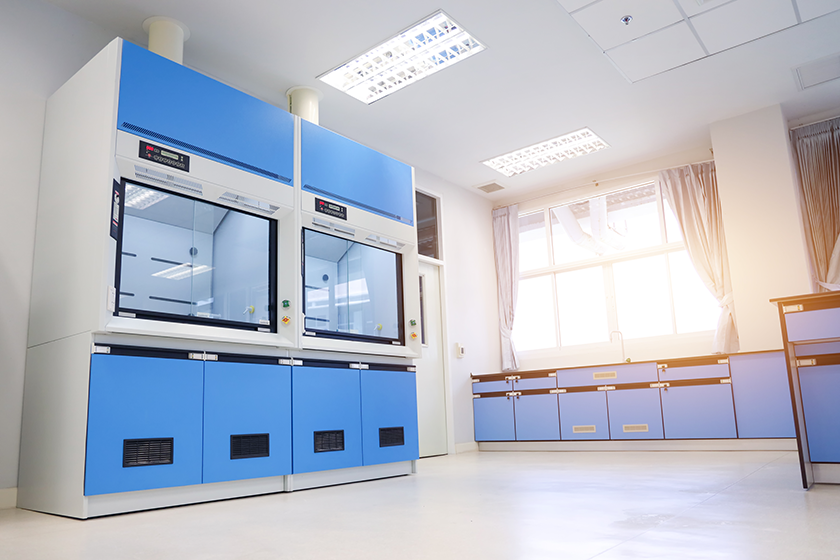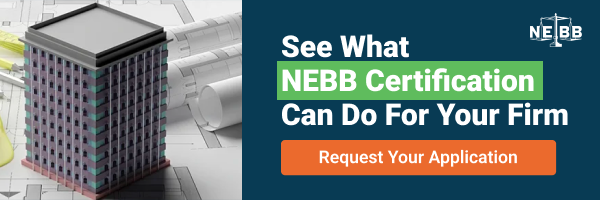
Historical use of perchloric acid in selected laboratory fume hoods has posed a difficult challenge to planned laboratory renovations when the fume hoods were not equipped with safety controls to prevent the build-up of perchloric acid crystals within the ductwork. In this situation, duct removal by demolition trades workers without performing decontamination can cause the ductwork to explode, as the dry perchloric acid crystals are potentially flammable and shock explosive.
Modern fume hoods, which are designed for perchloric acid use, employ wash-down systems to remove the majority of these crystals from building up inside the hood work area and similarly use effluent scrubbers to prevent perchloric acid migration into the ductwork.
What are the Dangers of Perchloric Acid Deposition?
Perchloric acid (ClHO4) is a colorless liquid at room temperature. It is popular in chemical processing because it offers all the desirable properties of mineral acids without introducing ions such as chloride, nitrate, and sulfate, which often interfere with other chemical reactions. When hot and concentrated, perchloric acid can also be a powerful oxidizing and dehydrating agent.
The unique and unusual properties of perchloric acid make it desirable for use in many chemical processes, including use as a dehydrating agent, an oxidizing agent, a solvent for metals and alloys, and in the destruction of organic matter. Perchloric acid is also used in a number of commercial processes due to its strong acidic nature and the ease by which its oxidation power can be controlled by concentration and temperature.
If hot perchloric acid is used in a fume hood that does not have internal wash-down capabilities, the acid vapors may accumulate on internal portions of the duct. As the perchloric acid dries, it leaves behind a perchlorate salt that resembles white crystal deposits. These perchlorate salts will show up over time in the hood, baffles, filters, fans, ducts, and exhaust stacks and can be flammable and highly explosive when subjected to heat, impact or reaction with other specific chemicals.
How Should Fume Hood Professionals Evaluate It?
Fume hoods which are suspected to contain perchloric acid can be evaluated and tested for the presence of these crystals by use of inspection and laboratory analyses by an experienced consultant or decontamination specialist. Much of what is known about these hazards has been learned by a world laboratory community from tragic explosions during renovation or demolition activities over the last century. Current standards pertaining to the sampling and decontamination techniques are published online by the Brookhaven National Laboratory (BNL), a United States of America National Laboratory.
Testing and evaluation are limited to access provided by the current ductwork configuration. The situation does have a “Catch 22” scenario, as most fume hoods have sealed ductwork that cannot be readily accessed without cutting into the duct runs. The cutting cannot be employed due to the threat of perchloric deposits possibly being present.
Visual inspection by experienced personnel of the hood interior and the exhaust stack openings for whitish deposits can be performed to the extent allowed. Swab surface sampling following the BNL procedure can be performed inside the fume hood and exhaust stack at the heaviest deposition points. Field blanks and background samples are essential to establish a baseline for the analysis results within the building.
Analysis is performed using High-Performance Liquid Chromatography/Mass Spectroscopy, employing Environmental Protection Agency (EPA) analysis method 6850. This sampling and inspection protocol can give a very accurate picture as to the likelihood of significant perchloric deposits being present.
Prior to the development of this testing method, a previous method used in industry was methylene blue test solution. This method, which provides an immediate visual outcome, is not useful as it has been proven to yield both false negative and false positive results due to interactions with other chemical residues which often are present. Currently, this type of testing has been determined to not be useful when assessing fume hoods for perchloric acid presence.
The swab sampling is performed in a known-sized area (using a template), collecting all deposits within the area. Once analyzed, the amount of perchlorate and/or perchlorate salts detected in that sample can be expressed in a concentration when taking into account the size of the sample area. From this information, comparable concentrations can be determined, and NPFA 45 and BNL Procedure have listed concentration levels that can be considered “negative,” “suspect,” or “positive” for the presence of perchlorate deposits.
How to Build a Remediation Plan After Evaluation
Should it be concluded from testing and inspection that decontamination of the fume hoods and ductwork is necessary, the method to employ is flushing the ductwork with large volumes of water for a minimum of 24 hours. This poses significant logistical problems in many cases due to the type and location of ductwork and access points. Designing a decontamination protocol must be performed on a case-by-case basis to prevent water leakage or infiltration into adjacent areas.
From a general safety standpoint, projects of this nature should be planned during periods of low building occupancy. From an industrial hygiene standpoint, the workers who are performing these procedures must be protected using Personnel Protective Equipment (PPE) for a physical perspective and a chemical perspective.
Chemically, they will be protected through the use of Tyvek or chemical suits, gloves, face shields, respirators, etc. From a physical perspective, the workers will require the use of ballistic gear (body protection helmets, face shields, etc.) that are composed of Kevlar or equivalent protective materials, similar to what bomb disposal unit personnel wear.
After decontamination, the ductwork should be dismantled by personnel equipped with ballistic gear. The dismantling should still be performed as a “wet” demolition method where possible and as warranted by testing results. Further rinsing and/or soaking in water of the removed duct metal can be performed prior to the material being disposed of as uncontaminated waste.
In some cases, this may be performed by submerging the duct sections into a tank, bin, or vessel on-site for soaking (again for 24 hours). For heavy or stubborn deposits (and again, depending on the results of testing), some scraping and/or physical cleaning can be employed to remove deposits, provided the work is entirely performed as a wet method.
How Fume Hood Professional Should Dispose of Perchloric Acid
Projects of this nature are evaluated in terms of the effectiveness of the procedures, taking into account the levels of deposits and results of initial testing. Thoroughly soaked and cleaned metal components can often be safely disposed of as uncontaminated waste after visual inspection and review of all aspects of the project.
Depending on the location of the project, the water used to rinse, clean, and/or soak the ductwork and metal may be disposed of in sanitary drains or, in some municipalities, may require collection (of all cleaning/soaking water throughout the project) and specialized disposal, or pre-treatment prior to disposal.
